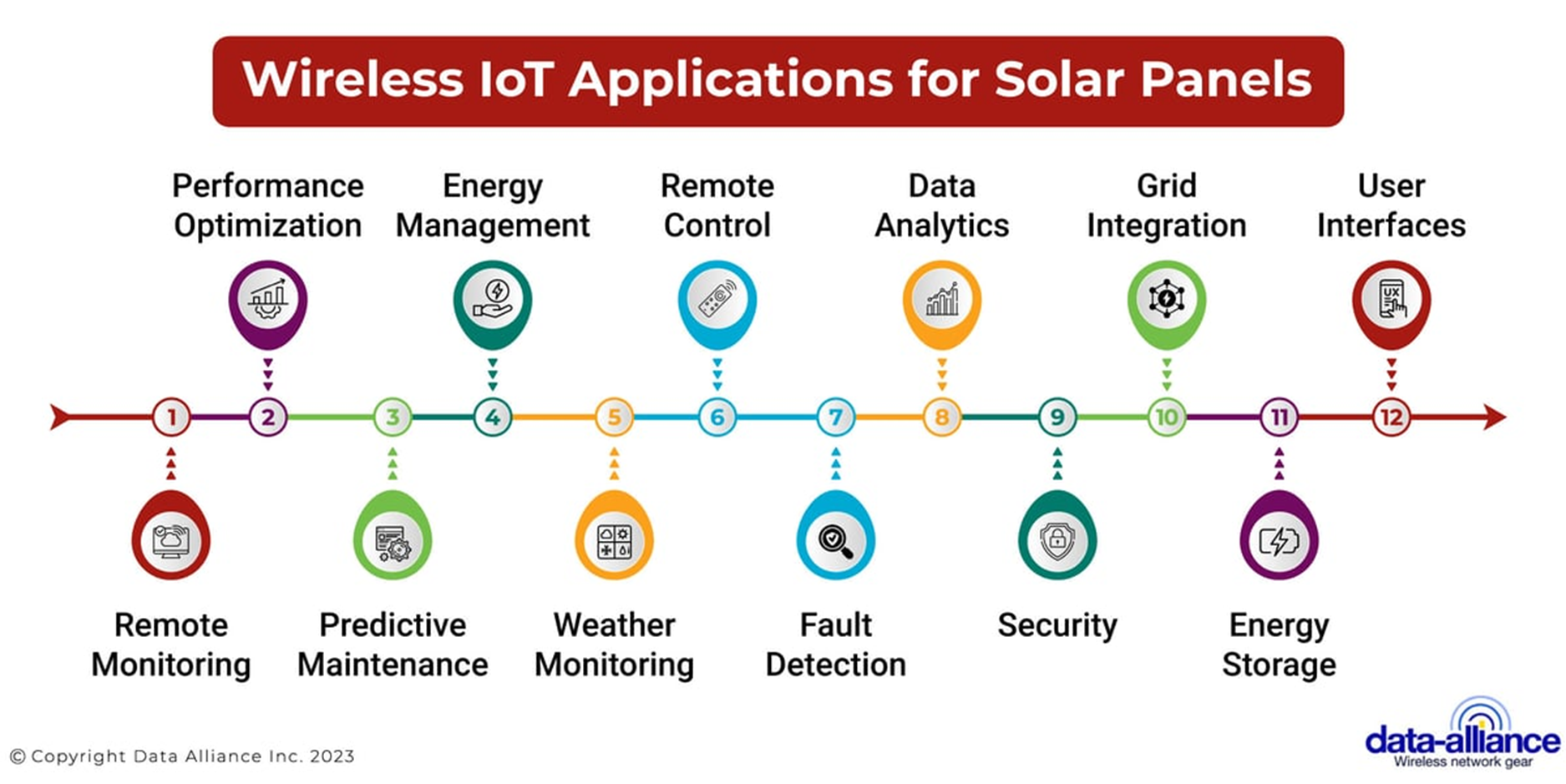Antennas, Antenna Cables, Wireless Products: Technical Articles
Solar Panel Wireless Technologies and Protocols: IoT Integration
Wireless IoT Connectivity for Solar Panels
IoT (Internet of Things) technology is being increasingly integrated into solar panel systems to enhance their efficiency, monitoring, and maintenance. Here are several ways in which IoT is used in solar panels:
Remote Monitoring
- IoT sensors are installed on solar panels and inverters to collect data on energy production, panel temperature, voltage, current, and other relevant parameters. This data is transmitted to a central cloud-based platform for real-time monitoring.
Performance Optimization
- By continuously monitoring the performance of individual solar panels, IoT systems can detect and diagnose issues such as shading, dirt buildup, or faulty panels. This information enables operators to take corrective actions promptly and optimize energy production.
Predictive Maintenance
- IoT analytics can predict when solar panels or inverters are likely to fail based on performance data. This proactive approach allows for scheduled maintenance, reducing downtime and repair costs.
Energy Management
- IoT-enabled solar panels can integrate with smart home or building automation systems. This allows users to monitor energy consumption, optimize energy usage, and even sell excess energy back to the grid.
Weather Monitoring
- IoT sensors can track weather conditions, including temperature, humidity, and sunlight intensity. This information helps in predicting energy generation and adapting system settings accordingly.
Remote Control
- IoT technology can enable remote control of solar panel systems. For instance, solar arrays can be tilted or cleaned remotely to maximize energy capture.
Fault Detection
- IoT systems can quickly identify and report any faults or malfunctions in solar panels or inverters, allowing for rapid response and minimizing downtime.
Data Analytics
- IoT-generated data can be analyzed to identify trends and patterns, helping users make informed decisions about energy consumption and generation.
Security
- IoT devices can enhance the security of solar panel installations. They can detect and alert owners about unauthorized access or tampering with the system.
Grid Integration
- IoT-enabled solar panels can communicate with the grid to balance energy production and consumption. They can feed excess energy into the grid when production exceeds demand and draw power from the grid when needed.
Energy Storage
- IoT technology can be integrated with energy storage solutions, such as batteries. This allows users to store excess energy generated during the day for use during nighttime or cloudy days.
User Interfaces
- IoT platforms often provide user-friendly interfaces, such as mobile apps or web portals, that allow homeowners, facility managers, or solar farm operators to monitor and control their solar panel systems conveniently.
By incorporating IoT technology into solar panel systems, users can maximize energy production, reduce operational costs, increase system reliability, and contribute to a more sustainable and efficient energy infrastructure. It also facilitates the transition to smart grids and smart cities by integrating renewable energy sources seamlessly.

Wireless Technologies Used for IoT integration into Solar Panels
IoT integration into solar panels and related components often relies on various wireless technologies to enable seamless communication between sensors, monitoring devices, and central data processing systems. These wireless technologies play a critical role in collecting data, optimizing solar panel performance, and ensuring efficient management. Here are some of the key wireless technologies used in IoT-integrated solar panel systems:
Wi-Fi
- Wi-Fi connectivity is commonly used for IoT-enabled solar panels in residential and commercial applications. It provides high-speed data transfer and allows users to access real-time performance data through their local networks or the internet.
Cellular Networks (3G, 4G, 5G)
Bluetooth
- Bluetooth technology, particularly Bluetooth Low Energy (BLE), is used for short-range communication between solar panel components and mobile devices. It is often employed for configuration, control, and monitoring of individual panels or inverters.
Zigbee
- Zigbee is a low-power, wireless communication protocol commonly used in home automation and energy management systems. It can be utilized to connect and control IoT devices in a solar panel installation, such as inverters or smart meters.
Z-Wave
- Z-Wave is another wireless protocol for home automation and IoT applications. It can be integrated into solar panel systems to facilitate communication between devices and enable remote monitoring and control.
LoRa and LoRaWAN (Long Range)
- LoRa is a low-power, long-range wireless technology suitable for IoT applications in remote or wide-area solar installations. It enables communication over long distances with minimal power consumption.
NB-IoT (Narrowband IoT) and LTE-M
RFID (Radio-Frequency Identification)
- RFID tags and readers can be used to track and manage solar panels and related equipment. These tags may store information about panel specifications, installation date, and maintenance history.
Satellite Communication
- In remote or off-grid solar installations, satellite communication can provide reliable connectivity for data transmission and remote monitoring of solar panel performance.
Mesh Networks
- Mesh networking technologies, like Zigbee or Thread, can be used to create a self-healing, robust communication network among IoT devices in a solar panel system, ensuring reliable data transmission.
Near Field Communication (NFC)
- NFC technology can enable quick and secure data transfer for configuration and maintenance tasks in solar panel installations.
The choice of wireless technology depends on various factors, including the application, location of the solar panels, power requirements, data transfer speed, and the available infrastructure. Solar panel manufacturers and system integrators often select the most appropriate wireless technology or combination of technologies to meet the specific needs of their IoT-integrated solar panel systems.







